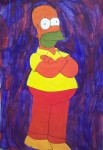Students will demonstrate proper color mixing and paint application through the creation of a color wheel.
Students will show the pop culture of their generation by creating a poster in the style of either Lichtenstein, Warhol, or Max.
1. Pencils
2. Erasers
3. Rulers
4. Tempera Paint
5. Brushes
6. 12 x 18 White Paper
7. 24 x 36 White Paper
8. Computers to Research Images
9. Black Permanent Markers
10. Circle Templates (Lichtenstein)
Need these materials?
Visit Blick!
1. Presentation and Discussion on Color Theory (1 Session)
2. Demonstration in paint mixing and application
-Students begin working on color wheels (1 Session)
4. Student finish painting their color wheels (1 Session)
5. Discussion and Presentation on Pop Art, Artists, Copyright, and Image Selection (Project Samples and Graded Criteria are also gone over) (1 Session)
6. Day in the Computer Lab
-Students search for an image for their poster.
-Students place their image in a grid using Microsoft Word. (Discuss and demonstrate adding the appropriate grid to the selected image.)
-Grids can be found in the documents section of
www.artwithmrkozak.webs.com
(1 Session)
7. Demonstrate drawing a grid on 12x18 (Warhol, fit 4 in 24x36), 12x12 (Warhol, fit 4 in 24x24), and 24x36 (Lichtenstein, Max) paper depending on the selected artist.
-Students begin drawing out their image using the grid to enlarge to keep all parts in proportion. (1 Session)
8. Draw image on large paper or smaller paper to transfer multiple times onto the larger paper. (Approximately 4 Sessions)
9. Students paint their image following their chosen style (Approximately 8-10 Sessions)
10. Students complete a critique reflecting on the content and process of the project. (1 Session)
This project is assessed using a rubric that related to the criteria listed in the Power Point.
Students really seem to get into this project because they get to pick images that relate to their interests. Make sure to discuss the issues of copyrighting. This is the only project that we use images like this in my room, so this is when we have that discussion.


Share!
Comment!